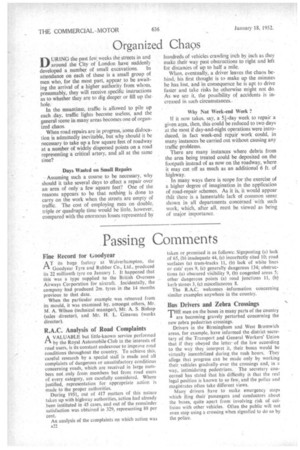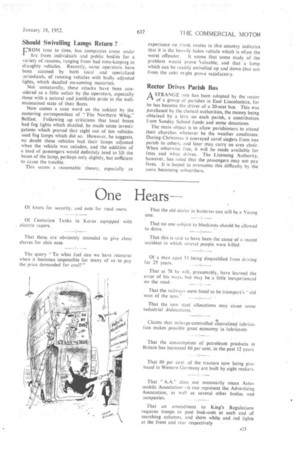Passing Comments
Page 24

Page 25

If you've noticed an error in this article please click here to report it so we can fix it.
Fine Record tor Goodyear
AT its huge factory at Wolverhampton, the Goodyear Tyre and Rubber Co., Ltd., produced its 22 millionth tyre on January 1. It happened that this was a type supplied to the British Overseas Airways Corporation for aircraft. Incidentally, the company had produced 2m. tyres in the 14 months previous to that date.
When the particular example was retnoved from its mould, it was examined by, amongst others, Mr. M. A. Wilson (technical manager), Mr. A. S. Bishop (sales director), and Mr. H. 1. Ginaven (works director).
R.A.C. Analysis of Road Complaints
A VALUABLE but little-known service performed ri by the Royal Automobile Club in the interests of road users, is its constant endeavour to improve road conditions throughout the country. To achieve this, careful research by a special staff is made and all complaints of dangerous or unsatisfactory conditions concerning roads, which are received in large numbers not only from members but from road users of eyery category, are carefully considered. Where justified, representation for appropriate action is made to the proper authorities. During 1951, out of 417 matters of this nature taken up with highway authorities, action had already been instituted in 45 cases, and out of the remainder satisfaction was obtained in 329, representing 88 per cent.
An analysis of the complaints on which action was A22 taken or promised is as follows: Signposting (a) lack of 65, (b) inadequate 44, (c) incorrectly sited 10; road surfabes (a) tram-tracks 11, (b) lack of white lines or cats' eyes 9, (c) generally dangerous 134; obstructions (a) obscured visibility 9, (b) congested areas 5; other dangerous points (a) road junctions 11, (b) kerb stones 3, (c) miscellaneous 8.
The R.A.C. welcomes -information concerning similar examples anywhere in the country.
Bus Drivers and Zebra Crossings
THE men on the buses in many parts of the country are becoming gravely perturbed concerning the new zebra pedestrian crossings.
Drivers in the Birmingham and West Bromwich areas, for example, have informed the district secretary of the Transport and General Workers' Union that if they obeyed the letter of the law according to the way they interpret it, their buses would be virtually iramObilized during the rush hours. The allege that progress can be made only by working their vehicles gradually over the crossings and, in a way, intimidating pedestrians. The secretary concerned has stated that his difficulty is that the real legal position is known to so few, and the police and magistrates often take different views.
Many drivers have to make emergency stops which fling their 'passengers and conductors about the buses, quite apart from involving risk of collision with other vehicles. Often the public will not even stop using a crossing when signalled to do so by the police.
Should Swivelling Lames Return ?
FROM time to time, bus companies conic tinder tire from individuals and public bodes for a variety of reasons, ranging from bad time-keeping to draughty vehicles. Recently, some operators have been accused by both loCal and specialized ?eriodicals, of running vehicles with badly adjusted lights, which dazzled on-coming motorists.
Not unnaturally, these -attacks have been coniidered as a little unfair by the operators, especially those with a natural and justifiable pride in the wellmaintained state of their fleets.
Now comes a sane word on the subject by the motoring correspondent of ".The Northern Whig," Belfast. Following up criticisms that local buses had fog lights which dazzled, he made some investigations which proved. that eight out of ten vehicles used fog lamps which .did so. However, he suggests, no doubt these vehicles had their lamps adjusted when the vehicle was unladen, and the addition of a load of passengers would definitely tend to lift the beam of the tamp, perhaps only slightly, but sufficient to cause the trouble..
This seems a reasonable theory, especially as experience on trunk routes in this country indicates that it is the heavily laden vehicle which is often the worst offender. It seems that some study of the problem would prove 'valuable, and that a /amp which can be readily swivelled up and down (but not from the cab) might prove satisfactory.
Rector Drives Parish Bus
ASTRANGE role has been adopted by the rector
of a group of parishes in East Lincolnshire, for he has become the driver of a 20-seat bus. This was purchased by the clerical authorities, the money being obtained by a levy on each parish, a contribution from Sunday School funds and some donations.
The main object is to allow parishioners to attend their churches whatever be the weather conditions. During Christmas it conveyed carol singers from one parish to others, and later may carry an area choir. When otherwise free, it will be made available for fetes and whist drives.. The Licensing Authority, however, has ruled that the passengers may not pay fares. It is hoped to overcome this difficulty by the users becoming subscribers.




















































































